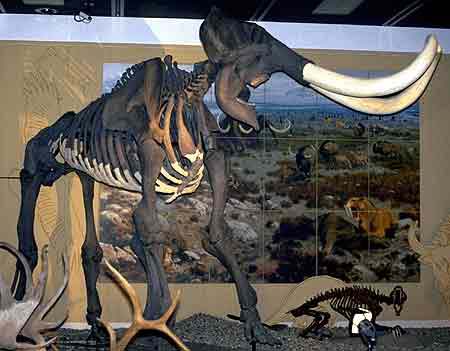The reporter of the magazine "Scientific American" accompanied fossil researchers in Canada, who are searching underground for remains of DNA from giant extinct mammals. The remains may reveal how and when creatures like the mammoth became extinct, and also explain global warming
By: Charles K. Choi

Dawson City, Canada. The gas-powered core drill, designed for drilling into concrete, revs up the engine with a roar and begins digging through 100,000-year-old ice. Here, in the Klondike River Valley, the drill serves as a kind of manual time machine, bringing up from the depths frozen soil from the Pleistocene, the golden age of mammoths and other giant mammals. In this land, where the miners are still looking for gold, Ross McPhee, a mammal fossil researcher from the American National Museum of Nature in New York, and his colleagues are looking for a different kind of treasure: the DNA of extinct giants.
"Every spring, thousands of years ago, the thawing ground in the Klondike Range would crack and fill with water, which would freeze again in the winter and form ice wedges," explains geologist Dwayne Pruas from the University of Alberta. Along with the water, sediments from the surface of the ground also dripped into the cracks, possibly containing the DNA of mammoths or of plants, bacteria and other animals that existed in the area at the time. We know nothing about the genetics of mammoths in the middle of the Pleistocene, and such DNA can tell about their evolution. The researchers hope to find conclusive evidence that at the end of the last ice age two species of mammoth lived and roamed the Americas and not one.
This region of land, most of which today is covered with conifer, cedar and poplar forests, was once part of Beringia - the grassland that stretched between North America and Asia and today lies mostly at the bottom of the frozen Bering Sea. Every summer for the past 15 years, Prous has been coming to the Klondike region with the aim of compiling a complete picture of Beringia in the last millions of years. Sampling sediments trapped in the cracks of the earth in search of DNA may be an easy way to analyze the changes in ecosystems in Beringia over time, much more than collecting hundreds of fossils of different species.
When I accompanied the team of researchers in June 2008, for seven days, I learned that DNA molecules are not the only clue they are looking for here. Paleontologist Svetlana Kuzmina of the University of Alberta looks for insect fossils in these sediments. According to the places where modern insects of the types whose fossils you will find here live today, Kuzmina will be able to learn about the climate in ancient Beringia. Lee Arnold of the University of Wollongong in Australia is scanning crystal grains to accurately determine the age of the other finds, which will help clarify the sequence of events. Correct arrangement of events is analogous to correct arrangement of words in a sentence. Then the scientists will travel north, by plane, helicopter and boat, to look for bones.
Help the gold miners
Continued gold mining in the Klondike is very helpful for research. Thanks to it, you can travel along the mine roads right up to the research site, without having to walk and carry the heavy equipment on your back. The miners are also very helpful for research. At one rocky site, Paradise Hill, they even helped remove tons of dirt from the frozen ground with their mining excavators. Their help also makes the research cheaper, explains Proas, and McPhee agrees and adds: "In Siberia, you have to say thank you when you manage to take care of one site a week."
Still, field work is a difficult and dirty task. The huge ice wedge we carved into, at Gold Run Creek on the fourth day of the trip, lay beneath a slope of powdery rot - a drift rich in ancient organic matter, rotting and smelling like organic manure. When we exposed the ice to the sun, the thawing water mixed with the rot and created a slippery and drowning mud that unfortunately and unpleasantly we sometimes sank up to our thighs. Time in the field is also sometimes wasted in unexpected ways, as we found out when the rough dirt roads took their toll on our rental SUV, puncturing three tires in two days.
Mysteries waiting to be solved
This scientific treasure, which researchers work so hard to obtain, may help solve some mysteries. McPhee hopes, for example, that the DNA that will be revealed will explain why so many giant mammals became extinct in America. Did sudden climate change wipe them out? And maybe the pile of human hunters? Or perhaps, as McPhee guesses, diseases brought here by humans and passed between species?
This research work may also hint at the future of the planet. At the Lucky Lady mine site there are layers of soil from about 100,000 years ago, from the last interglacial period, that is, from the break between the two expansions of the glaciers in the north of the Earth. At that time the world was warmer than now, so the analysis of the precipitation from those days can shed light on today's global warming, says Proas. (He discovered the site following a meeting with the owner of the mine, a paleontology enthusiast, at the bar "Maorat Tsafoni" in Dawson City). As we wallowed deep in the mud, I asked McPhee if this was the glamorous life of paleontologists. He smiled and replied: "There is no glamor in it."
The article was published in the November issue of "Scientific American - Israel"
